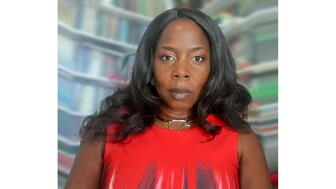“Shell Auranova” is the next generation of the brand’s bridal line, featuring half-bezel engagement rings with bold and fluid designs.
Why the GIA Grades Lab-Grown Diamonds Like It Does
The GIA’s Tom Moses explains the reasoning behind the more general color and clarity grades the lab assigns to synthetic stones.

Earlier this week, I wrote a story about two large lab-grown diamonds--one 5.19 carats and the other a 10.08-carat blue--recently examined by the Gemological Institute of America’s laboratory in Hong Kong.
In both articles, I noticed the GIA using the following terminology to refer to the stones’ color and clarity: “J-equivalent color” and “VS2-equivalent clarity” for the white diamond, and color equivalent to “fancy deep blue” for the colored stone.
This terminology, for me at least, raised questions about the GIA’s approach to grading synthetic diamonds.
On Wednesday, the very knowledgeable Tom Moses, the GIA’s executive vice president and chief laboratory and research officer, took some time to explain it to me.
Moses said the GIA has been issuing Synthetic Diamond Grading Reports for about 10 years.
On these reports, the GIA does not give specific color or clarity grades.
Instead, Moses said, it grades lab-grown diamonds in broader terms, calling, for example, stones in the D-E-F range “colorless” and those in the G-H-I range “near colorless.”
For clarity, the lab uses only VVS, VS, SI or I for synthetic diamonds.
Why?
Because, “by their very nature, when they grow these diamonds, they are traditionally nitrogen poor,” Moses said, which is, incidentally, also what makes them Type IIa. In addition, many, though not all, CVD-grown diamonds come out a sort of brown color and then are de-colorized through a treatment process to make them colorless or near colorless.
All this is to say that these stones are not going to have the same range of color (D to Z) as mined diamonds, which is why the GIA chooses to use broader categories in grading them. They are grown to be as clear as possible, too, which is why the GIA also uses broader terms for clarity.
The GIA’s grading system, which was created long before the proliferation of lab-grown stones that we see today, was “developed for normal mine run, which doesn’t change. That’s nature,” Moses noted.
However, when the GIA publishes research articles online--like this one on the 5.19-carat diamond that appeared earlier this month--it uses terms such as “J-equivalent color” and “VS-equivalent clarity” to give readers a clearer picture of the stone.
Moses said despite what some people seem to think, the GIA is not doing this to “punish diamond growers.” Rather, the lab just sees it as the most logical way to describe lab-grown diamonds.
He added that from a consumer perspective, he doesn’t think
“They’re going to say, ‘It looks nice. They sparkle. They’re the price I want to spend. I’ll take them.’”
(I think this same argument could be made for mined diamonds as well, but that’s another topic for another time.)
Moses said while lab-grown diamond companies do ask the GIA to do it differently, he doesn’t see the GIA altering its system in the near future, especially with the improving diamond-growing technology producing more stones of high color and clarity.
“Our mission is to serve the consumer and provide clear and accurate information,” he said. “Although we listen to the industry, ultimately, we are here to serve the public.”
“Right now, I just don’t see a reason why we would make that change.”
The Latest

Boucheron and Pomellato performed well in an otherwise bleak quarter for Kering amid struggles at Gucci.

The company said it expects sightholders to remain “cautious” with their purchasing due to all the unknowns around the U.S. tariffs.

Six new retail businesses were selected for the 2025 program, which began in January.

Sponsored by the Gemological Institute of America


A third-generation jeweler, Ginsberg worked at his family’s store, Ginsberg Jewelers, from 1948 until his retirement in 2019.

The company failed to file its quarterly reports in a timely manner.

The risk of laboratory-grown diamonds being falsely presented as natural diamonds presents a very significant danger to consumer trust.

The organization also announced its board of directors.

Charms may be tiny but with their small size comes endless layering possibilities, from bracelets to necklaces and earrings.


Located in Valenza, the now 355,000-square-foot facility includes a new jewelry school that’s open to the public, Scuola Bulgari.

Paola Sasplugas, co-founder of the Barcelona-based jewelry brand, received the Fine Jewelry Award.

A platinum Zenith-powered Daytona commissioned in the late ‘90s will headline Sotheby’s Important Watches sale in Geneva next month.

The basketball stars wear men’s jewelry from the “Curb Chain” collection.

The Signet Jewelers-owned retailer wants to encourage younger shoppers to wear fine jewelry every day, not just on special occasions.

The 21 pieces, all from a private collector, will be offered at its Magnificent Jewels auction next month.

Lilian Raji answers a question from a reader who is looking to grow her jewelry business but has a limited marketing budget.

GCAL by Sarine created the new role to sharpen the company’s focus on strategic partnerships and scalable expansion.

The Indiana jeweler has acquired Scottsdale Fine Jewelers in Scottsdale, Arizona.

“Cartier: Design, Craft, and Legacy” opened earlier this month at the Victoria and Albert Museum in London.

Van Cott Jewelers in Vestal, New York, is hosting a going-out-of-business sale.

Industry veteran Samantha Larson has held leadership roles at Borsheims, McTeigue & McClelland, Stuller, and Long’s Jewelers.
The two organizations will hold the educational event together this fall in Mississippi.

The entrepreneur and “Shark Tank” star will share his top tips for success.

The Ukrainian brand’s new pendant is modeled after a traditional paska, a pastry often baked for Easter in Eastern European cultures.

The jeweler has announced a grand reopening for its recently remodeled location in Peoria, Illinois.

The “Strong Like Mom” campaign features moms who work at Tiffany & Co. and their children.



























